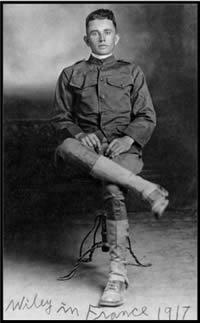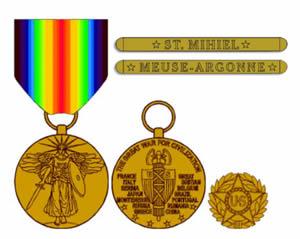
 From images of Shelby County, Texas, 1992, Light & Champion From images of Shelby County, Texas, 1992, Light & Champion |
Corporal Wiley Bryan Hayden
Company A, 360th Infantry Regiment, 90th Infantry Division
United States Army, World War I
©By Larry Hume, VFW Post 8904, Center, Texas
 It was called “The Great War” and the “War To End All Wars”. World War I was centered in Europe and began on July 28th, 1914 and lasted until November 11th, 1918. The United States did not enter World War I until April 6, 1917 when German submarines sank seven US merchant ships. President Woodrow Wilson tried for two and one half years to keep the United States neutral, even after Germany sunk the passenger liner RMS Lusitania in 1915 in defiance of international law. Germany’s all out submarine warfare on all commercial ships headed toward Britain was the last straw.
It was called “The Great War” and the “War To End All Wars”. World War I was centered in Europe and began on July 28th, 1914 and lasted until November 11th, 1918. The United States did not enter World War I until April 6, 1917 when German submarines sank seven US merchant ships. President Woodrow Wilson tried for two and one half years to keep the United States neutral, even after Germany sunk the passenger liner RMS Lusitania in 1915 in defiance of international law. Germany’s all out submarine warfare on all commercial ships headed toward Britain was the last straw.
On June 5th, 1917 twenty-one year old farmer Wiley Bryan Hayden of Precinct 14, Tenaha, Texas completed his draft registration card # 1097. Soon thereafter he was off to boot camp at Camp Travis near San Antonio and would find himself assigned to the 360th Infantry Regiment of the 90th Infantry Division. The training was grueling, the days were long and the discipline stiff. In late May 1918 the 360th left Camp Travis, reached Camp Mills, New York on June 12th and landed in Southampton, England on June 21st. After more training the regiment was pronounced fit for combat on August 20th, 1918.
From August 21st to October 6th, 1918 his regiment participated in the St. Mihiel Offensive which was one of the most significant battles of World War I. Next they saw action in the Meuse-Argonne Offensive that was a part of the final Allied offensive until the Armistice on November 11th. This battle was the largest in United States military history involving 1.2 million American soldiers. On November 12th, the 360th Regiment was withdrawn from the line to a rest camp for a few weeks before beginning the long march into Germany for the occupation. During these two campaigns the 360th Infantry Regiment suffered a total of 254 killed in action, 952 wounded and 32 missing in action
Christmas of 1918 began months of garrison duty in Germany but on May 17th, 1919 the regiment said farewell to Germany. They arrived in St. Nazaire, France on May 20th and on the evening of May 27th the entire regiment boarded the steamship Mongolia and docked at the Army pier in Boston, Massachusetts. The War Department sent orders that the regiment was to parade at Houston, Texas and then proceed to Camp Travis for demobilization. The regiment arrived in San Antonio at 3:00 pm on June 17th and were immediately formed for another parade. On the morning of June 18th the demobilization started, and the next morning the first men received their discharges and left for their homes. The demobilization was completed and the regiment ceased to exist on June 21st, 1919.
In a period covering less than two years, Wiley Bryan Hayden and his comrades had come from all walks of life, became soldiers, ensured victory and were now returning to their homes forever changed. Wiley returned to Shelby County and resumed his previous vocation of farming that he had known since his birth on May 24th, 1896. His parents were John R. and Henrietta Tatum Hayden and he grew up with six older siblings. Soon after his discharge from the US Army he married Irene Gunter (1897–1978) on December 13th, 1919 and they raised two children, Maurine Annette (1922-2009) and Bill (1925-2000). An infant son John died at birth on January 20th, 1921.
On April 27th, 1942 at the age of 45 Wiley Hayden once again registered for the draft with Local Board # 1, Shelby County, Texas. Although he was not called to service his son Bill did serve in the Pacific with the US Navy during WW II and was discharged in 1946. Wiley died of a cerebral hemorrhage at the age of 69 on February 10th, 1965 at the Shelby General Hospital in Center, Texas and was buried the next day at Cedar Yard Cemetery.
Note: Mr. Frank Buckles the last surviving WW I Veteran died on February 27th, 2011 at the age of 110.

World War I Victory Medal, front and back with lapel pin
Corporal Hayden would have worn the two campaign clasps shown attached to the ribbon.
(Sources: Wikipedia, December, 2014; History of the 360 Infantry, April 15, 1919; Ancestry.com, December 2014; Light and Champion book, Images of Shelby County, Texas 1992; FindAGrave.com, December 2014; Clothing and Heraldry, US Army.)









